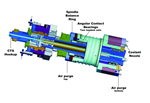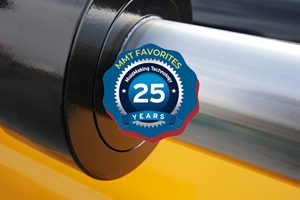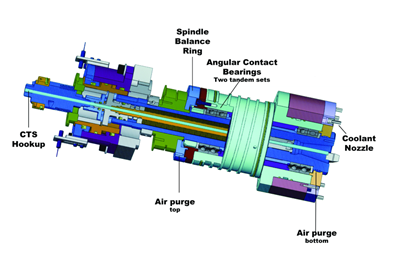Getting to Know Your Machine Tool
A review of the six core components of a machine tool: automatic toolchanger, motor/drive/encoder, base casting, OSP control, turret and spindle.
When looking to purchase a machine tool for your shop, it is vital to choose a machine tool supplier that designs, engineers and builds its own components. That way you are ensured of optimum performance at greater accuracies. And—if something should go wrong—your supplier can quickly get to the root of the problem since they were in charge of everything that went into that machine.
So before you buy, here is what you need to know about the six core components of a machine tool.
1. Automatic Tool Changer (ATC)
It is important that the ATC exchanges tools within the spindle as quickly as possible. By matching the drives and the motors the ATC arm hands off the tool to the spindle accurately. A good ATC system has the ability to decrease downtime and increase productivity.
2. Motor/Drive/Encoder
Once again, if you are having parts move, you need to match the best motor for that machine, and the best drive, and the best way to achieve this is to ensure your supplier is not using any outside components. They should design and build all of the electronic drive boards, electric motors, and absolute encoder systems that provide feedback to the control. Sophisticated communication within the system allows the machines to deliver some of the highest metal removal rates alongside positioning repeatability in the single digit micrometer range.
3. Base Casting
Since the base casting is the foundation of the machine center, the heavier and more rigid, the better. It may cost more, but the strength and durability will minimize vibration. If you have vibration, you are not controlling where the waves are going to be mounted. Tough machines will absorb the toughest horsepower cuts with the greatest accuracy.
4. Control
The control is the heart of the machine tool. It is telling the machine what to move, where to move, and how exactly to achieve the optimal cutting time, speed and feeds that you need. The blend of electrical and systems engineering give the controls a full range of power, heightened accuracy and ease of operation—turning data quickly from a CAD source into finished parts at the least cost per component. The machine tool supplier needs to be in control of their design for optimal matched control with the optimal matched machines.
5. Turret
The machine tool supplier should create each turret to match a specific machine and should capitalize on available horsepower and efficiently remove material without sacrificing accuracy. A durable turret increases the strength of the cutting process. Suppliers that design their own turrets enable them to only require one drive for the turret and milling function on the tool. Once again, if you have parts that are moving, who better to control it?
6. Spindle
The spindle is one of the most critical elements of the machine tool. A stable spindle incorporates the drive motor with the spindle—taking into account rigidity, lubrication and power, and also ensures consistently accurate finished parts and predictable productivity. Again, its design—with the optimum rpm rotation in mind—will give you the best cut and accuracy for that machine. Machine tool suppliers who design their own spindles can rebuild and support the spindles, extending the life and productivity of your machine.
One Source
Make sure the supplier designs, engineers and builds all of the machine’s key components so the system can be matched better. By using one source you can ensure the communication will be correct between drives and motors and the control itself.
Related Content
How to Correctly Size a Hydraulic Cylinder
This week Randy shares steps for correctly sizing a hydraulic cylinder on a mold.
Read MoreThe Ins and Outs of Hot Runner Temperature Control
A training checklist that explains the why and how of proper hot runner temperature control and system management.
Read MoreMold Design Review: The Complete Checklist
Gerardo (Jerry) Miranda III, former global tooling manager for Oakley sunglasses, reshares his complete mold design checklist, an essential part of the product time and cost-to-market process.
Read MoreMachining Center Spindles: What You Need to Know
Why and how to research spindle technology before purchasing a machining center.
Read MoreRead Next
Machining Center Spindles: What You Need to Know
Why and how to research spindle technology before purchasing a machining center.
Read MoreHow to Use Strategic Planning Tools, Data to Manage the Human Side of Business
Q&A with Marion Wells, MMT EAB member and founder of Human Asset Management.
Read MoreAre You a Moldmaker Considering 3D Printing? Consider the 3D Printing Workshop at NPE2024
Presentations will cover 3D printing for mold tooling, material innovation, product development, bridge production and full-scale, high-volume additive manufacturing.
Read More





















